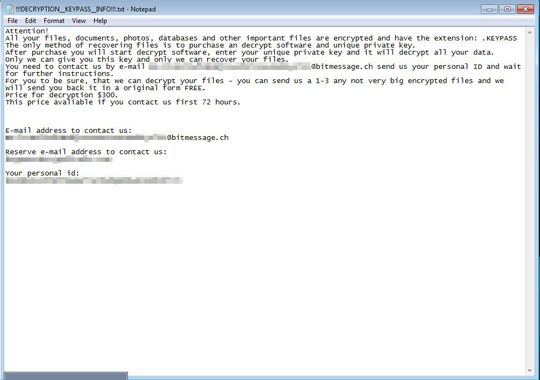RANSOM_ENCODER.TIHADAI
Trojan-Ransom.Win32.Encoder.n (Kaspersky) ; Trojan:Win32/Skeeyah.A!rfn (Microsoft)
Windows


Threat Type: Ransomware
Destructiveness: No
Encrypted: No
In the wild: Yes
OVERVIEW
This Ransomware arrives on a system as a file dropped by other malware or as a file downloaded unknowingly by users when visiting malicious sites.
It connects to certain websites to send and receive information. However, as of this writing, the said sites are inaccessible. It deletes itself after execution.
It drops files as ransom note.
TECHNICAL DETAILS
Arrival Details
This Ransomware arrives on a system as a file dropped by other malware or as a file downloaded unknowingly by users when visiting malicious sites.
Installation
This Ransomware drops the following copies of itself into the affected system and executes them:
- %AppDataLocal%\{Malware Name}.exe
(Note: %AppDataLocal% is the Local Application Data folder, which is usually C:\Documents and Settings\{user name}\Local Settings\Application Data on Windows 2000, XP, and Server 2003, or C:\Users\{user name}\AppData\Local on Windows Vista, 7, and 8.)
It drops the following files:
- %User Temp%\delself.bat -> used to delete the malware copy and itself
(Note: %User Temp% is the current user's Temp folder, which is usually C:\Documents and Settings\{user name}\Local Settings\Temp on Windows 2000, XP, and Server 2003, or C:\Users\{user name}\AppData\Local\Temp on Windows Vista, 7, and 8.)
It adds the following processes:
- %AppDataLocal%\{Malware Name}.exe
- %User Temp%\delself.bat
- %AppDataLocal%\{Malware Name}.exe --Admin
- %AppDataLocal%\{Malware Name}.exe" --ForNetRes x5I74v4h003xJ0iyhUfHQ8W6o0RDSicmSfg72KVA 6se9RaIxXF9m70zWmx7nL3bVRp691w4SNY8UCir0
- %AppDataLocal%\{Malware Name}.exe" --Service {Random Hex} x5I74v4h003xJ0iyhUfHQ8W6o0RDSicmSfg72KVA 6se9RaIxXF9m70zWmx7nL3bVRp691w4SNY8UCir0
- %AppDataLocal%\{Malware Name}.exe" --Service {Random Hex} x5I74v4h003xJ0iyhUfHQ8W6o0RDSicmSfg72KVA 6se9RaIxXF9m70zWmx7nL3bVRp691w4SNY8UCir0
(Note: %AppDataLocal% is the Local Application Data folder, which is usually C:\Documents and Settings\{user name}\Local Settings\Application Data on Windows 2000, XP, and Server 2003, or C:\Users\{user name}\AppData\Local on Windows Vista, 7, and 8.. %User Temp% is the current user's Temp folder, which is usually C:\Documents and Settings\{user name}\Local Settings\Temp on Windows 2000, XP, and Server 2003, or C:\Users\{user name}\AppData\Local\Temp on Windows Vista, 7, and 8.)
Autostart Technique
This Ransomware adds the following registry entries to enable its automatic execution at every system startup:
HKEY_CURRENT_USER\Software\Microsoft\
Windows\CurrentVersion\Run
SysHelper = %AppDataLocal%\{Malware Name}.exe --AutoStart x5I74v4h003xJ0iyhUfHQ8W6o0RDSicmSfg72KVA 6se9RaIxXF9m70zWmx7nL3bVRp691w4SNY8UCir0
Other Details
This Ransomware connects to the following website to send and receive information:
- cosonar.{BLOCKED}r.ru/get.php
It does the following:
- Have a hidden form that can be display by pressing ALT+F8

- The Attacker can customize the following data:
- Key
- Filename of Ransom Note
- Content of Ransom Note
- Personal ID
- Extension to be appended on the encrypted files
- List of paths that will not be encrypted
However, as of this writing, the said sites are inaccessible.
It deletes itself after execution.
Ransomware Routine
This Ransomware avoids encrypting files found in the following folders:
- C:\Windows\
- C:\Program Files (x86)\Mozilla Firefox\
- C:\Program Files (x86)\Internet Explorer\
- C:\Program Files (x86)\Google\
- C:\Program Files\Mozilla Firefox\
- C:\Program Files\Internet Explorer\
- C:\Program Files\Google\
- D:\Windows\
- D:\Program Files (x86)\Mozilla Firefox\
- D:\Program Files (x86)\Internet Explorer\
- D:\Program Files (x86)\Google\
- D:\Program Files\Mozilla Firefox\
- D:\Program Files\Internet Explorer\
- D:\Program Files\Google\
It drops the following file(s) as ransom note:
- {Encrypted Folder}\!!!DECRYPTION_KEYPASS_INFO!!!.txt

SOLUTION
Step 1
Before doing any scans, Windows XP, Windows Vista, and Windows 7 users must disable System Restore to allow full scanning of their computers.
Step 2
Note that not all files, folders, and registry keys and entries are installed on your computer during this malware's/spyware's/grayware's execution. This may be due to incomplete installation or other operating system conditions. If you do not find the same files/folders/registry information, please proceed to the next step.
Step 3
Restart in Safe Mode
Step 4
Delete this registry value
Important: Editing the Windows Registry incorrectly can lead to irreversible system malfunction. Please do this step only if you know how or you can ask assistance from your system administrator. Else, check this Microsoft article first before modifying your computer's registry.
- In HKEY_CURRENT_USER\Software\Microsoft\Windows\CurrentVersion\Run
- SysHelper = %AppDataLocal%\{Malware Name}.exe --AutoStart x5I74v4h003xJ0iyhUfHQ8W6o0RDSicmSfg72KVA 6se9RaIxXF9m70zWmx7nL3bVRp691w4SNY8UCir0
- SysHelper = %AppDataLocal%\{Malware Name}.exe --AutoStart x5I74v4h003xJ0iyhUfHQ8W6o0RDSicmSfg72KVA 6se9RaIxXF9m70zWmx7nL3bVRp691w4SNY8UCir0
Step 5
Search and delete this file
- {Encrypted Folder}\!!!DECRYPTION_KEYPASS_INFO!!!.txt
- %User Temp%\delself.bat
- %AppDataLocal%\{Malware Name}.exe
Step 6
Restart in normal mode and scan your computer with your Trend Micro product for files detected as RANSOM_ENCODER.TIHADAI. If the detected files have already been cleaned, deleted, or quarantined by your Trend Micro product, no further step is required. You may opt to simply delete the quarantined files. Please check this Knowledge Base page for more information.
Step 7
Restore encrypted files from backup.
Did this description help? Tell us how we did.

